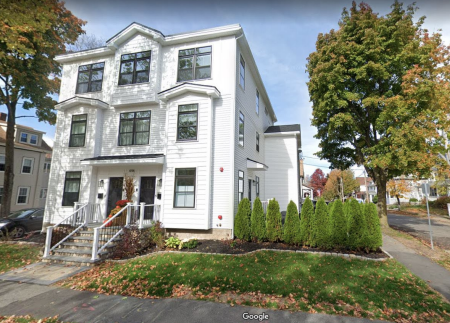By MARK SARDELLA
WAKEFIELD – Most of the residents who spoke at last week’s Planning Board forum on the new, state mandated multi-family zoning district questioned why the town’s compliance plan goes well beyond what is required by the state, both geographically and in terms of housing units added.
In 2020, the Massachusetts Zoning Act (Section 3A of Massachusetts General Laws Chapter 40A) was amended to promote the production of multi-family housing within walking distance of public transportation to address a “severe regional housing shortage.” The state claims that there is a shortage of up to 200,000 housing units.
“Multi-family housing near transit creates walkable neighborhoods with climate and transportation benefits,” according to the Executive Office of Housing and Livable Communities, “including better access to work/services, increased utilization of public transit and reduced reliance on single-occupancy vehicles.”
The new Zoning Act requires all MBTA communities, including Wakefield, to create at least one multi-family zoning district of reasonable size near public transit in which multi-family housing is permitted as of right. “As of right” means that a developer may proceed without obtaining a Special Permit, variance, zoning amendment, waiver, or other zoning approval.
In the proposed district, the plan would allow up to four units in a three-story building with a height of up to 35 feet on a minimum lot size of 4,000 square feet.
MBTA communities have until Dec. 31, 2024 to create such a by-right multifamily zoning district. Communities that do not comply would be ineligible for certain state grants and other funding sources from the Commonwealth.
But the compliance plan devised by Wakefield’s “MBTA Communities Working Group” was criticized at last week’s public forum for allowing even more new multifamily housing density than what is required by the state. The district created by the Working Group is centered around the North Avenue commuter rail station, extending west as far as Auburn Street and east of downtown to Pleasant Street.
For Wakefield, the minimum size required for this new multi-family zoning district would be 114 acres, but the Working Group is proposing a multi-family zoning district of 145.5 acres – far exceeding state requirements. The Working Group’s plan would also allow 2,355 additional housing units to be created in the district, even though the state only requires 1,696 additional units.
“I don’t agree with extending the number of units and acreage beyond the minimum required,” said Park Avenue resident Tom Miller. He also questioned the idea that all these new residents would use public transportation instead of automobiles.
The existing transit system “is not the glowing system we would like to have,” he said. “Bringing several thousand new people in and expecting them to use it exclusively isn’t reasonable.”
Brandon LaRoche of 2 Dellanno Lane said that he was also concerned with going beyond the state mandate, arguing that doing so would change the character of the affected neighborhoods. He also worried about the impact that adding all this new housing would have on the town’s ability to reach the 10 percent affordable housing threshold needed to gain more control over 40B developments.
Central Street resident Julie Scott called the new 40A statute an “unfunded mandate.” She said that the state is doing nothing to help affected MBTA cities and towns with the infrastructure strains that the mandate will place on those communities. She noted that the neighborhoods immediately west and east of the North Avenue commuter rail station are some of the oldest in town with ancient gas and water lines. School enrollments in Wakefield are also “maxed out,” Scott said.
Scott also said that she did not understand why the town would voluntarily go beyond what the state is requiring.
John Sophia of Whittemore Terrace put it more bluntly.
“Is the objective to put as many units as possible in Wakefield by right?” he asked, calling the mandate “state-sponsored tyranny. Giving them any more than we absolutely have to is a mistake,” he added.
Frank Margarita of Summer Street feared that the new mandate would allow developers to start buying up single family homes and convert them to four-family homes. He wondered about the impact the new density would have on quality of life, “what we pay taxes for.”
Ron Ferrara of Morrison Road West maintained that the housing plan will have an impact on public safety and the schools.
Carlotta Miller of Park Avenue asked why the town’s plan exceeds what the state requires.
Planning Board Vice Chairman Jim Hogan, who also chairs the working group that developed the local compliance plan, replied that the Working Group felt that it made sense to have the housing density rise near the downtown areas where the added foot traffic would benefit businesses.
But Miller pointed out that, if the idea is to get people to use public transit, those people will be out of town all day.
Frank Conte of Second Street called the state’s mandate “very coercive,” referring to the state grant programs that will be unavailable to towns that do not comply. He also wondered what avenues the Attorney General would pursue against noncompliant communities.
Hogan said that the Attorney General has threatened to take noncompliant communities to court.
Ted Gaffney of Morrison Road West asked why not limit the increased housing density plan to the area between North Avenue and Main Street.
Hogan said that the numbers wouldn’t work with such a limited district unless the density was increased to 8-10 units per lot.
Gaffney agreed with other speakers that the town should not go beyond the minimum required, arguing that Wakefield “has done its fair share” to create additional housing.
“We don’t need to be eager beavers and go beyond the bare minimum,” he said.
Residents will have at least two more opportunities to weigh in on the town’s multi-family zoning compliance plan. The Planning Board has public forums scheduled for Tuesday, Nov. 14 and Tuesday, Dec. 12.
The plan is expected to go before the voters at the 2024 Annual Town Meeting. The town must be in compliance with the state requirements by Dec. 31, 2024.





